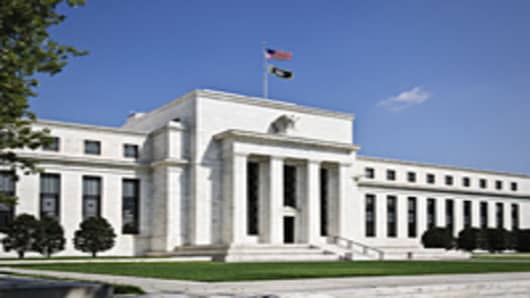The Federal Reserveon Tuesday resumed a debate on whether to pump billions of dollars more into the sluggish U.S. economy, but was likely to hold off to take further readings on the health of the recovery.
With a lofty 9.6 percent jobless rate and inflation running below levels the Fed would like, some officials may argue at a one-day policy meeting on Tuesday that the case for more easing is already made.
Others have made clear they would view a move as premature.
In the absence of action, financial markets will scour the Fed's post-meeting statement for any clues on how the internal debate is unfolding, and whether the central bank may be moving closer to relaunching large-scale purchases of government bonds.
The Fed began its meeting as scheduled at around 8 a.m., a Fed spokesman said. Policymakers are expected to release a statement outlining their thinking at around 2:15 p.m.
"Conditions have not deteriorated enough to spur a new round of asset purchases now, and we think the Fed recognizes that there is little to be gained by hinting at the possibility of expanding the balance sheet in the future," Wrightson ICAP Chief Economist Lou Crandall said in a note to clients.
Shortly after the Fed's meeting began, the government said housing starts jumped 10.5 percent in August, the latest in a recent string of better-than-expected economic news.
However, few economists expect the economy to suddenly regain vigor and many believe the Fed will launch another round of asset buying as soon as its next meeting in early November.
The Fed's easy money policies and the prospect of further easing have driven up the value of currencies in other countries, including Japan and Brazil, as investors moved out of the dollar in search of higher returns.
Japan intervened last week to weaken the yen, which had surged to a 15-year high against the dollar, and emerging markets are seeking ways to control huge capital inflows.
The Fed opened the door to further easing at its last gathering on Aug. 10, when it announced it would resume purchases of longer-term Treasury securities to prevent its portfolio—and support for the economy—from shrinking as mortgage-related debt it holds matures.
After slashing interest rates to zero, the Fed bought up $1.7 trillion in longer-term U.S. government debt and mortgage-linked bonds as a way to further lower borrowing costs.
Fed Chairman Ben Bernanke said in late August that while officials are ready to ease more if needed, they would do so only if the economic outlook deteriorated significantly.
Now, officials need to decide if the economy is at or nearing that threshold.
Many of the inflation-focused hawks on the Fed's policy-setting panel think it is not.
Richmond Federal Reserve Bank President Jeffrey Lacker, who is not a voter this year, said last week that he would support further easing if deflation were to become a real worry, but he added that the economy is "fairly far" from that now.
Indeed, a number of recent reports in addition to the housing starts data have suggested the economy could be tentatively emerging from the soft patch it encountered over the summer.
The job market was slightly stronger than expected in August, the U.S. trade deficit narrowed sharply in July, and businesses added more to inventories than forecast.
Still, core consumer prices were flat in August, while consumer sentiment deteriorated in early September, keeping concerns about economic weakness and the potential for deflation on the radar.
The Fed is also likely to have a lively discussion of whether renewing large-scale asset purchases will succeed in breathing fresh life into the economy, and whether the benefits of a resumption of asset purchases outweigh the risks.
Some officials worry the Fed's valued credibility would be hurt if it launched new purchases with little effect. Others fear the central bank could just be planting seeds for inflation.
The Fed's earlier massive asset purchases succeeded in lowering the yield on the 10-year Treasury note by about 0.5 percentage point, according to a Fed analysis.
Some Fed officials wonder whether further asset buys might see a diminishing return.
If officials agree to buy new assets, they also will need to consider whether to embark on an all-out attack with a massive purchase program or move more incrementally.


